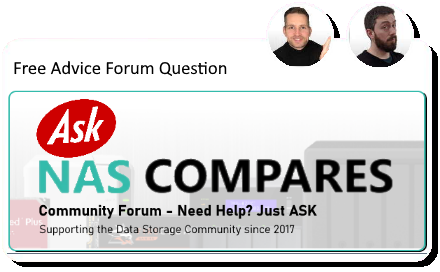06-20-2025, 12:07 PM
Both QNAP models you mentioned — the TS-973AX and TS-873AU — are solid choices. The TS-973AX offers a nice mix of 3.5” and 2.5” bays, which makes it quite flexible if you want to mix HDDs and SSDs, and it includes 10GbE for faster access. The TS-873AU, being rackmount and Ryzen-based, offers more performance headroom, which could help long-term, especially if you expand your access or run heavier apps down the line.
As for the long-term question — a system like either of those should absolutely hold up for 7–10 years with good drive maintenance and maybe a RAM upgrade or two. QNAP tends to support their models with firmware updates for many years, and as long as you’re not running high-resource apps, the hardware should remain plenty capable.
Regarding SSDs — they offer fast access and lower latency, but for a digital archive with a primary focus on read/write access rather than constant editing or large-scale database operations, HDDs are still the more cost-effective and practical choice, especially at 100TB+. SSDs don’t necessarily last longer in terms of write endurance at this scale, and they’re still much more expensive per TB. A good hybrid setup — caching with SSDs, bulk storage on HDDs — might be ideal, but isn’t essential.
On the other end, the UGreen DXP8000 Plus and TerraMaster T9-450 are indeed compelling on price and hardware layout, but you’re right to be cautious. The TerraMaster CPU is Arm-based and better suited for basic use; it’s not as flexible for apps or virtualization. UGreen’s DXP series has good specs on paper, but their software platform (at least right now) still feels young — fine for backups and streaming, but maybe not ideal if you want long-term dependability and community support.
If budget allows, I’d stick with QNAP. They’ve got better long-term support, broader drive and file system compatibility, and overall maturity as a platform — which sounds important for your archive work.
As for the long-term question — a system like either of those should absolutely hold up for 7–10 years with good drive maintenance and maybe a RAM upgrade or two. QNAP tends to support their models with firmware updates for many years, and as long as you’re not running high-resource apps, the hardware should remain plenty capable.
Regarding SSDs — they offer fast access and lower latency, but for a digital archive with a primary focus on read/write access rather than constant editing or large-scale database operations, HDDs are still the more cost-effective and practical choice, especially at 100TB+. SSDs don’t necessarily last longer in terms of write endurance at this scale, and they’re still much more expensive per TB. A good hybrid setup — caching with SSDs, bulk storage on HDDs — might be ideal, but isn’t essential.
On the other end, the UGreen DXP8000 Plus and TerraMaster T9-450 are indeed compelling on price and hardware layout, but you’re right to be cautious. The TerraMaster CPU is Arm-based and better suited for basic use; it’s not as flexible for apps or virtualization. UGreen’s DXP series has good specs on paper, but their software platform (at least right now) still feels young — fine for backups and streaming, but maybe not ideal if you want long-term dependability and community support.
If budget allows, I’d stick with QNAP. They’ve got better long-term support, broader drive and file system compatibility, and overall maturity as a platform — which sounds important for your archive work.





